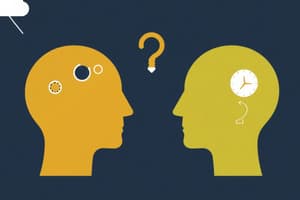Podcast
Questions and Answers
What is the primary issue addressed by production blocking in brainstorming sessions?
What is the primary issue addressed by production blocking in brainstorming sessions?
- Increased participation
- Improved group dynamics
- Loss of productivity (correct)
- Enhanced creativity
Which decision-making technique involves group members providing written responses without meeting face-to-face?
Which decision-making technique involves group members providing written responses without meeting face-to-face?
- Production Blocking
- Nominal Group Technique
- Skunkworks
- Delphi Technique (correct)
What is the role of a product champion within a project?
What is the role of a product champion within a project?
- To hinder project progress
- To take ownership and provide leadership (correct)
- To monitor team performance without involvement
- To execute tasks without leadership
What is the purpose of skunkworks in an organization?
What is the purpose of skunkworks in an organization?
Which of the following is NOT a characteristic of the nominal group technique?
Which of the following is NOT a characteristic of the nominal group technique?
What best describes programmed decision making?
What best describes programmed decision making?
Which process is typically associated with nonprogrammed decision making?
Which process is typically associated with nonprogrammed decision making?
What is the first step managers should take in the decision-making process?
What is the first step managers should take in the decision-making process?
How can cognitive biases affect managerial decision making?
How can cognitive biases affect managerial decision making?
What is a significant disadvantage of group decision making?
What is a significant disadvantage of group decision making?
What role does organizational learning play in decision making?
What role does organizational learning play in decision making?
Which option is NOT a characteristic of reasoned judgment?
Which option is NOT a characteristic of reasoned judgment?
What is a common behavior during programmed decision making?
What is a common behavior during programmed decision making?
What is a primary reason managers fail to gather complete information when making decisions?
What is a primary reason managers fail to gather complete information when making decisions?
What does the term 'satisficing' refer to in decision making?
What does the term 'satisficing' refer to in decision making?
What is an advantage of group decision making?
What is an advantage of group decision making?
What is groupthink?
What is groupthink?
What step should be taken to learn from feedback after a decision has been made?
What step should be taken to learn from feedback after a decision has been made?
What role do heuristics play in decision making?
What role do heuristics play in decision making?
Which of the following is a cognitive bias that affects decision making?
Which of the following is a cognitive bias that affects decision making?
How can group members prevent groupthink?
How can group members prevent groupthink?
What does the Classical Decision-Making Model assume about the decision maker's capabilities?
What does the Classical Decision-Making Model assume about the decision maker's capabilities?
What is the role of a devil’s advocate in group decision making?
What is the role of a devil’s advocate in group decision making?
What is meant by 'bounded rationality' within the Administrative Model?
What is meant by 'bounded rationality' within the Administrative Model?
How does diversity among decision makers affect groupthink?
How does diversity among decision makers affect groupthink?
What characterizes the uncertainty faced by decision makers in the Administrative Model?
What characterizes the uncertainty faced by decision makers in the Administrative Model?
Why do decision makers often settle for satisfactory rather than optimum decisions according to the Administrative Model?
Why do decision makers often settle for satisfactory rather than optimum decisions according to the Administrative Model?
What describes organizational learning?
What describes organizational learning?
What does 'ambiguous information' imply in decision-making?
What does 'ambiguous information' imply in decision-making?
What does a learning organization aim to maximize?
What does a learning organization aim to maximize?
What type of information deficiency occurs when the outcomes of a decision cannot be determined?
What type of information deficiency occurs when the outcomes of a decision cannot be determined?
Which condition primarily promotes individual creativity?
Which condition primarily promotes individual creativity?
In the context of decision-making, what is a consequence of incomplete information?
In the context of decision-making, what is a consequence of incomplete information?
What is a key characteristic of brainstorming in group creativity?
What is a key characteristic of brainstorming in group creativity?
What aspect of creativity is emphasized in decision making?
What aspect of creativity is emphasized in decision making?
What is the key difference between the Classical and Administrative models of decision making?
What is the key difference between the Classical and Administrative models of decision making?
How should feedback be given to promote creativity?
How should feedback be given to promote creativity?
Flashcards
Programmed Decision Making
Programmed Decision Making
Routine decisions made based on established rules or guidelines. Managers reuse past successful approaches.
Nonprogrammed Decision Making
Nonprogrammed Decision Making
Decisions made in response to unusual circumstances or unforeseen opportunities/threats.
Decision Making
Decision Making
The process managers use to analyze options, choose actions, and define organizational goals.
Intuition
Intuition
Signup and view all the flashcards
Reasoned Judgment
Reasoned Judgment
Signup and view all the flashcards
Managerial Decision Making
Managerial Decision Making
Signup and view all the flashcards
Routine Decisions
Routine Decisions
Signup and view all the flashcards
Unpredictable Decisions
Unpredictable Decisions
Signup and view all the flashcards
Classical Decision-Making Model
Classical Decision-Making Model
Signup and view all the flashcards
Administrative Model
Administrative Model
Signup and view all the flashcards
Bounded Rationality
Bounded Rationality
Signup and view all the flashcards
Incomplete Information
Incomplete Information
Signup and view all the flashcards
Risk
Risk
Signup and view all the flashcards
Uncertainty
Uncertainty
Signup and view all the flashcards
Ambiguous Information
Ambiguous Information
Signup and view all the flashcards
Satisfactory Decision
Satisfactory Decision
Signup and view all the flashcards
Time Constraints & Info Costs
Time Constraints & Info Costs
Signup and view all the flashcards
Satisficing
Satisficing
Signup and view all the flashcards
Heuristics
Heuristics
Signup and view all the flashcards
Systematic Errors
Systematic Errors
Signup and view all the flashcards
Groupthink
Groupthink
Signup and view all the flashcards
Learn from Feedback
Learn from Feedback
Signup and view all the flashcards
Advantages of Group Decisions
Advantages of Group Decisions
Signup and view all the flashcards
Decision-Making Criteria
Decision-Making Criteria
Signup and view all the flashcards
Production Blocking
Production Blocking
Signup and view all the flashcards
Nominal Group Technique
Nominal Group Technique
Signup and view all the flashcards
Delphi Technique
Delphi Technique
Signup and view all the flashcards
Product Champion
Product Champion
Signup and view all the flashcards
Skunkworks
Skunkworks
Signup and view all the flashcards
Devil's Advocacy
Devil's Advocacy
Signup and view all the flashcards
Diversity in Decision Making
Diversity in Decision Making
Signup and view all the flashcards
Organizational Learning
Organizational Learning
Signup and view all the flashcards
Learning Organization
Learning Organization
Signup and view all the flashcards
Senge's Principles
Senge's Principles
Signup and view all the flashcards
Creativity in Decision Making
Creativity in Decision Making
Signup and view all the flashcards
Promote Individual Creativity
Promote Individual Creativity
Signup and view all the flashcards
Brainstorming
Brainstorming
Signup and view all the flashcards
Study Notes
Chapter 5: Decision Making, Learning, and Creativity
- Decision Making: Managers respond to opportunities and threats by analyzing options and determining organizational goals and courses of action.
Learning Objectives
- Understand managerial decision-making, distinguishing between programmed and non-programmed decisions. Non-programmed decisions are complex and uncertain.
- Managers consider six steps for optimal decision-making
- Recognize how cognitive biases can lead managers to poor decisions.
- Identify the advantages and disadvantages of group decision-making and techniques to improve it.
- Understand the roles of organizational learning and creativity in enhancing decision quality.
Programmed Decisions
- Routine, automatic decisions following established rules or guidelines.
- Managers have made similar decisions repeatedly.
- Rules and guidelines based on past decisions are followed.
Non-programmed Decisions
- Nonroutine decisions for unusual and unpredictable opportunities/threats, e.g. developing new technology, starting a new business, entering a new market.
Decision Making: Intuition vs. Reasoned Judgment
- Intuition: A quick decision based on feelings, beliefs, and hunches, requiring minimal effort and information gathering.
- Reasoned judgment: A thoughtful decision that takes time and careful information gathering, alternative generation, and evaluation.
The Classical Model
- A prescriptive model assuming the decision-maker can identify and evaluate all possible choices and their consequences
- Decision-makers should choose the option leading to the best outcome for the organization
The Administrative Model
- Practical approach explaining why decision-making may be uncertain and risky
- Managers often opt for satisfactory instead of optimum decisions
- Bounded rationality and incomplete information are influential factors.
- Satisficing is a term that reflects making a satisfactory decision instead of an optimal one.
Incomplete Information
- Uncertainty and Risk: Uncertainty involves unknown probabilities of future outcomes, while Risk involves known probabilities.
- Ambiguous Information: Information that can be interpreted in multiple and conflicting ways.
- Time Constraints and Information Costs: Time and money limitations hinder comprehensive information gathering.
Satisficing
- Choosing an acceptable, satisfactory solution rather than an optimal one.
Steps in the Decision-Making Process
- Recognizing the need for a decision.
- Generating alternatives.
- Assessing alternatives.
- Choosing among alternatives.
- Implementing the chosen alternative.
- Learning from feedback
Evaluation Criteria
- Practical considerations.
- Economic feasibility.
- Ethical considerations
Learning from Feedback
- Comparing actual results to expected outcomes.
- Understanding unmet expectations.
- Developing future decision-making guidelines.
Cognitive Biases
- Heuristics: Rules of thumb based on experience, simplifying decision-making.
- Systematic Errors: Repeated errors leading to poor decisions.
- Examples of biases (e.g. confirmation bias, representativeness heuristic).
Group Decision Making
- Advantages: Superior to individual decision-making as it can minimize biases, leverage combined skills, improve alternative generation, and allow for more information processing.
- Disadvantages: Groupthink can occur, resulting in an overemphasis on achieving consensus and ignoring dissenting viewpoints or information.
Groupthink
- A pattern of faulty and biased decision-making in groups.
- Group members strive for consensus and ignore alternative viewpoints.
Techniques for Avoiding Groupthink
- Devil's advocacy: Critical analysis of the favored option.
- Encouraging diversity: Diverse teams are less susceptible to groupthink.
Organizational Learning
- The process of improving employee understanding and ability to manage the organization and its environment.
- It involves creativity and learning in a context of an organization.
Learning Organizations
- Maximizing individual and group creativity and potential for organizational learning improvement.
Senge's Principles for a Learning Organization
- Develop of personal mastery
- Build complex and challenging mental models
- Promote team learning
- Build shared visions
- Encourage system thinking
Creativity
- A decision-maker's ability to develop original and novel ideas for feasible alternative courses of action.
Promoting Individual Creativity
- Opportunity for new idea generation
- Opportunity to learn from errors
- No punishment for radical ideas
- Constructive feedback
Promoting Group Creativity
- Brainstorming: generating many alternatives without evaluation.
- Nominal Group Technique: individuals generate ideas in silence, are then discussed and rank ordered.
- Delphi Technique: group members respond in writing to questions.
Product Champions and Skunkworks
- Product Champion: Manager who takes ownership and provides leadership for a project from idea to customer.
- Skunkworks: A separate group dedicated to developing new products to encourage innovative thinking.
Studying That Suits You
Use AI to generate personalized quizzes and flashcards to suit your learning preferences.




